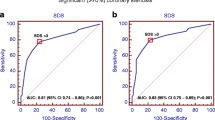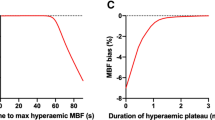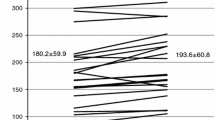Abstract
Myocardial perfusion imaging with adenosine triphosphate (ATP) has been used increasingly to diagnose coronary artery disease (CAD) and assess risk for this disease. This study compared absolute myocardial blood flow (MBF) and myocardial flow reserve index (MFR) with ATP and dipyridamole (DIP) in patients with CAD. MBF was quantified by15O-H2O PET in 21 patients with CAD (17 male, 4 female), aged 55 to 81 years. MBF was measured at rest, during intravenous injection of ATP (0.16 mg/kg/min), and again after DIP infusion (0.56 mg/kg). Regions of interest were drawn in nonischemic and ischemic segments based on findings from fhallium-201 (2O1T1) scintigraphy and coronary angiography (CAG). Absolute MBF values and indexes of MFR were calculated in nonischemic and ischemic segments. Intravenous injection of ATP and DIP significantly increased MBF in nonischemic (2.4 ± 0.9 and 2.1 ± 0.8 m//g/min, respectively; p < 0.01, for both) and in ischemic segments (1.3 ± 0.4 and 1.5 ± 0.4 m//g/min, respectively; p < 0.01, for both). There was a significant difference in MBF values between ATP and DIP in nonischemic segments (p < 0.05), which was not observed in ischemic segments. In nonischemic segments, ATP produced higher MFR than DIP (2.1 ± 0.8 and 1.8 ± 0.7, respectively; p < 0.05), while no significant difference was observed in ischemic segments (1.5 ± 0.6 and 1.7 ± 0.3, respectively). ATP produced a greater hyperemia than DIP between the ischemic and nonischemic myocardium in patients with CAD. ATP is as effective as DIP for the diagnosis of CAD.
Similar content being viewed by others
Reference
Gould KL, Lipscomb K. Effects of coronary stenoses on coronary flow reserve and resistance.Am J Cardiol 1974; 34:48–55.
Furchgott RF. Role of endothelium in responses of vascular smooth muscle.Circ Res 1983; 53:557–573.
Creager MA, Cooke JP, Mendelsohn ME, Gallagher SJ, Coleman SM, Loscalzo J, et al. Impaired vasodilation of forearm resistance vessels in hypercholesterolemic humans.J Clin Invest 1990; 86:228–234.
Panza JA, Quyyumi AA, Brush JE Jr, Epstein SE. Abnormal endothelium-dependent vascular relaxation in patients with essential hypertension.N Engl J Med 1990; 323:22–27.
Czernin J, Muller P, Chan S, Brunken RC, Porenta G, Krivokapich J, et al. Influence of age and hemodynamics on myocardial blood flow and flow reserve.Circulation 1993; 88:62–69.
Uren NG, Melin JA, De Bruyne B, Wijns W, Baudhuin T, Camici PG. Relation between myocardial blood flow and the severity of coronary-artery stenosis.N Engl J Med 1994; 330:1782–1788.
Uren NG, Crake T, Lefroy DC, de Silva R, Davies GJ, Maseri A. Reduced coronary vasodilator function in infarcted and normal myocardium after myocardial infarction.N Engl J Med 1994; 331:222–227.
Marinho NVS, Keogh BE, Costa DC, Lammerstma AA, Ell PJ, Camici PG. Pathophysiology of chronic left ventricular dysfunction; new insights from the measurement of absolute myocardial blood flow and glucose utilization.Circulation 1996; 93:737–744.
Vanhoutte PM. The endothelium: modulator of vascular smooth muscle tone.N Engl J Med 1998; 319:512–513.
Creager MA, Luscher TF, Cosentino F, Beckman JA. Diabetes and vascular disease: pathophysiology, clinical 717 consequences, and medical therapy: Part I.Circulation 2003; 108:1527–1532.
Homma S, Gilliland Y, Guiney TE, Strauss HW, Boucher CA. Safety of intravenous dipyridamole for stress testing with thallium imaging.Am J Cardiol 1987; 59:152–154.
Taillefer R, Amyot R, Turpin S, Lambert R, Pilon C, Jarry M. Comparison between dipyridamole and adenosine as pharmacologic coronary vasodilators in detection of coronary artery disease with thallium 201 imaging.J Nucl Cardiol 1996; 3:204–211.
Becker LC. Conditions for vasodilator-induced coronary steal in experimental myocardial ischemia.Circulation 1978; 57:1103–1110.
Stratmann HG, Tamesis BR, Younis LT, Wittry MD, Miller DD. Prognostic value of dipyridamole technetium-99m sestamibi myocardial tomography in patients with stable chest pain who are unable to exercise.Am J Cardiol 1994; 73:647–652.
Watanabe K, Sekiya M, Ikeda S, Miyagawa M, Kinoshita M, Kumano S. Comparison of adenosine triphosphate and dipyridamole in diagnosis by Thallium-201 myocardial scintigraphy.J Nucl Med 1997; 38:577–581.
Miyagawa M, Kumano S, Sekiya M, Watanabe K, Akutzu H, Imachi T, et al. Thallium-201 myocardial tomography with intravenous infusion of adenosine triphosphate in diagnosis of coronary artery disease.J Am Coll Cardiol 1995; 26:1196–1201.
Kubo S, Tadamura E, Toyoda H, Mamede M, Yamamuro M, Magata Y, et al. Effect of caffeine intake on myocardial hyperemic flow induced by adenosine triphosphate and dipyridamole.J Nucl Med 2004; 45:730–738.
DeGrado TR, Turkington TG, Williams JJ, Stearns CW, Hoffman JM, Coleman RE. Performance characteristics of a whole-body PET scanner.J Nucl Med 1994; 35:1398–1406.
Tadamura E, Mamede M, Kubo S, Toyoda H, Yamamuro M, Iida H, et al. The effect of nitroglycerin on myocardial blood flow in various segments characterized by rest-redistribution thallium SPECT.J Nucl Med 2003; 44:745–751.
Katoh C, Ruotsalainen U, Laine H, Alenius S, Iida H, Nuutila P, et al. Iterative reconstruction based on median root prior in quantification of myocardial blood flow and oxygen metabolism.J Nucl Med 1999; 40:862–867.
Iida H, Rhodes CG, de Silva R, Araujo LI, Bloomfield PM, Lammertsma AA, et al. Use of the left ventricular timeactivity curve as a noninvasive input function in dynamic oxygen-15-water positron emission tomography.J Nucl Med 1992; 33:1669–1677.
Cerqueira MD, Weissman NJ, Dilsizian V, Jacobs AK, Kaul S, Laskey WK, et al. Standardized myocardial segmentation and nomenclature for tomographic imaging of the heart: a statement for healthcare professionals from the Cardiac Imaging Committee of the Council on Clinical Cardiology of the American Heart Association.Circulation 2002; 105:539–542.
Iida H, Kanno I, Takahashi A, Miura S, Murakami M, Takahashi K, et al. Measurement of absolute myocardial blood flow with H215O and dynamic positron-emission tomography: strategy for quantification in relation to the partial-volume effect.Circulation 1988; 78:104–115.
Dilsizian V, Freedman NM, Bacharach SL, Perrone-Filardi P, Bonow RO. Regional thallium uptake in irreversible defects. Magnitude of change in thallium activity after reinjection distinguishes viable from nonviable myocardium.Circulation 1992; 85:627–634.
Klaubunde RE. Dipyridamole inhibition of adenosine metabolism in human blood.Eur J Pharmacol 1983; 93:21–26.
West JW, Bellet S, Manzoli UC, Muller OF. Effects of persantine (RA8), a new coronary vasodilator, on coronary blood flow and cardiac dynamics in the dog.Circ Res 1962; 10:35–44.
Fitzgerald GA. Dipyridamole.N Engl J Med 1987; 316:1247–1257.
Biaggioni I, Killian TJ, Mosqueda-Garcia R, Robertson RM, Robertson D. Adenosine increases sympathetic nerve traffic in humans.Circulation 1991; 83:1668–1675.
Muramatsu I, Fujiwara M, Miura A, Sakakibara Y. Possible involvement of adenine nucleotides in sympathetic neuroeffector mechanisms of dog basilar artery.J Pharmacol Exp Ther 1981; 216:401–409.
Sneddon P, Burnstock G. ATP as a co-transmitter in rat tail artery.Eur J Pharmacol 1984, 106:149–152.
Langer SZ. Presynaptic regulation of the release of catecholamines.Pharmacol Rev 1981; 32:337–362.
Paton DM. Presynaptic neuromodulation mediated by purinergic receptors. In: Burnstock G (ed),Purinergic Receptors: Receptors and recognition. London; Chapman and Hall, 1981: 199–219.
Su C. Purinergic neurotransmission and neuromodulation.Annu Rev Pharmacol Toxicol 1983; 23:397–411.
Yokoyama I, Momomura S, Ohtake T, et al. Reduced coronary flow reserve in hypercholesterolemic patients without overt coronary stenosis.Circulation 1996; 94:3232–3238.
Author information
Authors and Affiliations
Corresponding author
Rights and permissions
About this article
Cite this article
Mamede, M., Tadamura, E., Kubo, S. et al. Comparison of myocardial blood flow induced by adenosine triphosphate and dipyridamole in patients with coronary artery disease. Ann Nucl Med 19, 711–717 (2005). https://doi.org/10.1007/BF02985121
Received:
Accepted:
Issue Date:
DOI: https://doi.org/10.1007/BF02985121




